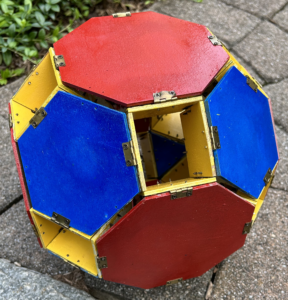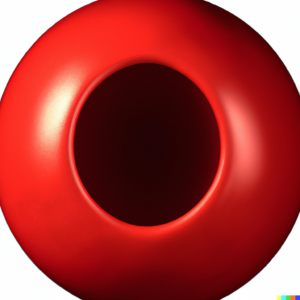
Genus 11 Stewart Toroid, wood, paint, and brass
[76 F, 168 E, 72 V] Why is this shape different from all the others? Why does it not hang in the same plane as the rest?
All of the other shapes in Polyplane are “spherical,” meaning that their corners and edges can be mapped onto a sphere without any edges crossing. But this one is “toroidal”: all of its corner-edge connections can only be untangled on a pretzel-like shape with 11 holes!
It’s perhaps even more remarkable that this contorted structure can consist only of regular polygons: squares, equilateral triangles, hexagons, and octagons, with brass hinges connecting the edges. There are 54 squares in all: 48 yellow and the other six red (can you see the reds when you peek inside?). The red squares extend via yellow squares into six red octagons, centered at the vertices of a regular octahedron. Also on the inside are eight blue triangles, extending via yellow squares to eight blue hexagons, centered at the vertices of a cube. This shape is possible due to the marvelous fact that 24 is both 6×4 and 8×3; indeed, each of the six red squares is adjacent to four yellow squares, while each of the eight blue triangles are adjacent to three yellow squares. The two different groups of 24 make up the 48 yellow squares.
In all, there are F = 54+6+8+8 = 76 sides (or “faces”), meeting at E = 168 edges, which themselves meet at V = 72 corners (or “vertices”). Notice that for this polyhedron, V − E + F = 72−168+76 = -20, whereas for all of the other shapes in Polyplane, V − E + F = 2. Since it’s that relation between V, E, and F that defines the plane of Polyplane, this model lies off that plane.
What’s more, this example hints at one of the many generalizations that the Euler Polyhedron Formula has inspired. Namely, the Euler characteristic formula states that
V − E + F = 2 − 2g,
where g is the “genus,” or number of holes, of the surface on which the polyhedron lies. In this case, we see that g = 11 makes this polyhedron satisfy the Euler characteristic formula. This observation brings us back to where we started, that this model can be drawn on a surface with 11 holes.

However, if you examine this model carefully and try to count the holes, it may seem rather clear that it has 12 symmetrically placed tunnels into the empty cavity in the middle, and that each tunnel should constitute a “hole.” However, consider an ordinary sphere squashed down to a pancake. That clearly has no holes, but you could now wrap that pancake mostly around some empty space to produce something looking like the image at right (with thanks to DALL-E). That appears to have one “hole”, but it’s still just a (very) distorted sphere, which we know has no holes.

Working in the other direction, suppose we had a stretchy, rubber model of this polyhedron. We could stretch out one of the apparent holes a great deal until it just became a big border around the whole model, which we could then flatten out, leaving only 11 “essential” holes, as predicted by the Euler characteristic formula. Similarly, a t-shirt with its waist hem stretched out in all directions has only three holes in it (as shown in the picture on the left), even though when you wear it, your head, left arm, right arm, and torso (four things) are all sticking “out” from the t-shirt.
Finally, the claim that this is the only shape in Polyplane that has “holes” might seem confusing, when other models very clearly seem to have holes. However, in all of those other cases, the holes are simply artistic cutouts in some of the faces, which are considered to be there even though they haven’t been completely covered with physical material. (In fact, some artworks go so far as to physically model only the corners and edges, leaving us to imagine the flat surfaces that would be stretched across their frameworks to make the faces.) In this model, by contrast, every face is a solid piece of wood, yet you could tie a rope into the middle of the model through one tunnel and out via a different tunnel and then into a loop. That loop would never penetrate into the interior of the polyhedron (the space really inside, completely surrounded by wood) and yet it could never be pulled or slipped off. That’s the kind of “essential” hole that none of the other models possess.
Artist’s notes: The title of this piece recognizes the groundbreaking work of mathematician Bonnie Stewart on the properties of toroidal polyhedra. Constructing such polyhedra poses particular technical challenges: it’s necessary to first identify the internal cavity and build it “inside out” as compared with spherical polyhedral models. Then the faces connecting that cavity with those lying on the exterior must be added, leaving those exterior faces until last. This construction order explains why some of the hinges lie on top of the faces they connect and some are underneath.